In This Article
- Immediate Aftermath: Strikes and UN Assessment
- Retaliation and Regional Response
- Administration's Stance: De-escalation vs. Rhetoric
- Uncertain Long-Term Consequences
Following the US military's targeted strikes on Iranian nuclear facilities, President Donald Trump has hailed the operation as a "bullseye" success. However, the United Nations has yet to determine the full extent of the damage caused by the attacks, leaving the situation in the region fraught with uncertainty.
Despite Iran's retaliatory missile launches toward Israel, fears of an immediate assault on American forces stationed across the Middle East—numbering over 40,000 troops—have not materialized. US officials have emphasized that the strikes were not part of a broader offensive campaign, a message seemingly echoed in Vice President JD Vance's recent remarks. "We're not at war with Iran," Vance stated during a television interview. "We're at war with Iran's nuclear program."
However, President Trump's Sunday evening post on Truth Social, which hinted at the possibility of regime change in Iran, has added complexity to the situation. While framed as a question, the president's comments starkly contrast with his administration's efforts to de-escalate tensions. Analysts suggest that such rhetoric could influence Iran's strategic decisions, particularly if its leadership perceives an existential threat to its power.
As the international community watches closely, the long-term implications of these strikes remain uncertain. The UN continues to assess the impact of the attacks, while regional stability hangs in the balance.








Comments (0)
Leave a Comment
Be the first to comment on this article!